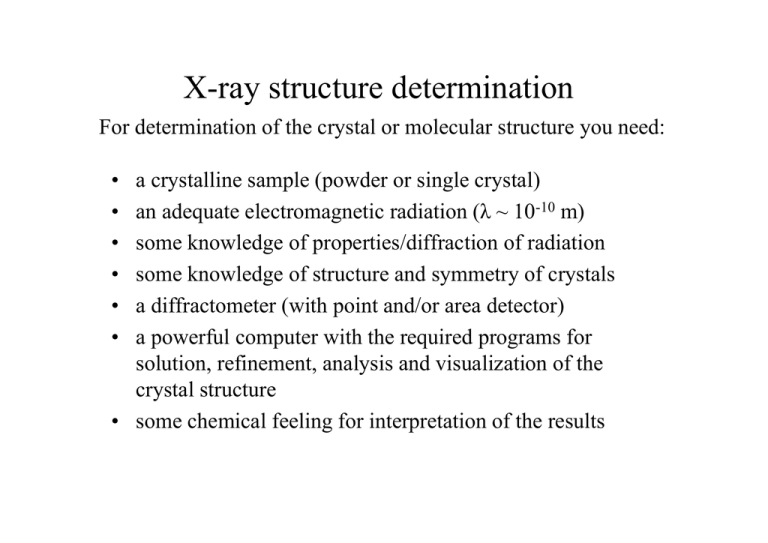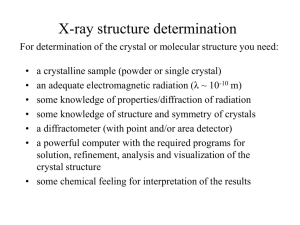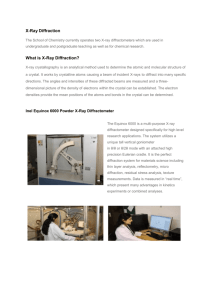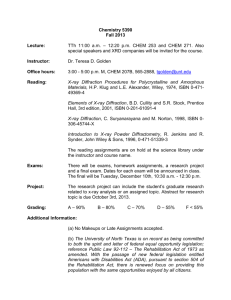X-ray structure determination
advertisement

X-ray structure determination
For determination of the crystal or molecular structure you need:
•
•
•
•
•
•
a crystalline sample (powder or single crystal)
an adequate electromagnetic radiation (λ ~ 10-10 m)
some knowledge of properties/diffraction of radiation
some knowledge of structure and symmetry of crystals
a diffractometer (with point and/or area detector)
a powerful computer with the required programs for
solution, refinement, analysis and visualization of the
crystal structure
• some chemical feeling for interpretation of the results
Electromagnetic Radiation
tranversal waves, velocity c0 ≈ 3 · 108 m s-1
Characteristics
1. Energy (eV, kJ mol-1)
-frequency
ν (ν = c0 / λ ; s-1, Hz)
-wavelength
λ (λ = c0 / ν ; Å, nm, ..., m, ...)
~ν (ν~ = 1/λ = ν /c ; cm -1 , Kaiser)
-wavenumber
0
energy ~ frequency
~ wavenumber
~ wavelength-1
2. Intensity
3. Direction
4. Phase
cross-section
r
s
wavevector 0
phase
(E = h · ν)
(E = h ⋅ν~ ⋅ c o )
(E = h · c0 / λ)
r2 r r
I ~|S| = | E×H|
ϕ
Range of frequencies for structural analysis: 106-1020 Hz i.e. 10-12 – 102 m
γ-ray, x-ray, ultraviolet (UV), visible (VIS), infrared (IR), micro-, radiowaves
(X-ray) Diffraction of a Sample
(gas, liquid, glass, (single-) crystal (-powder))
I(θ)
λ = 2dhkl·sinθhkl (Bragg‘s law)
scattered beam
r
s
r
s0
r
s0
x-ray
source
incident
beam
r r r 2θ
S = s - s0
beam stop
sample
detector
(film, imaging plate)
r
s 0 : WVIB
r
r
s : WVSB; | s | = | s 0 | = 1 / λ (or 1)
r
S : Scattering Vector
r r
S = H (Bragg' s law)
Fouriertransform of the Electron-Density Distribution
sample
r
ρ ( r)
r
r r
R(S) = ∫ ρ ( r ) exp(2πi r ⋅ S)dV
V
r
r
r r
ρ ( r ) = 1 / V ∫ R(S) exp(-2πi r ⋅ S)dV*
diffr. pattern
r
R(S)
V*
V : volume of sample
r
S
r
r
: vector in space R : scattering amplitude
: scattering vector ≡ vector in Fourier (momentum) space
Superposition (diffraction) of scattered X-rays - Bragg´s law
Only if nλ = 2d·sinθ or λ = 2dhkl·sinθhkl (Bragg‘s law, hkl: Miller indices),
scattered X-rays are „in phase“ and intensity can be non-zero.
Depending on the degree of order of the scattering sample this leads to:
A. X-ray scattering diagram of an amorphous sample
I(θ)
no long-range order, no short range order
(monoatomic gas e.g. He) ⇒ diffuse scattering with monotoneous decrease
I(θ) = N·f2
(n)
f = scattering length of atoms N
⇒ no information
θ
I(θ)
no long-range, but short range order
(e.g. liquids, glasses) ⇒ diffuse scattering with modulation
I(θ ) =
N
∑f
j =1
2
j
+ 2∑
j>
∑
[
r r r
f j f i cos π ( rj - ri ) S
]
i
⇒ radial distribution function
atomic distances
θ
B. X-ray scattering diagram of a crystalline sample
I(θ)
n·λ = 2d sinθ (Bragg‘s law)
r
I(θ ) = f(f j , rj )
θ
crystal powder
orientation statistical, λ fixed
⇒ cones of interference
Debye-Scherrer diagram
single crystal
orientation or λ variable
⇒ dots of interference (reflections)
precession diagram
Principle of Powder Diffraction
A powder sample results in cones with high intensity of scattered beams.
Above conditions result in Bragg’s law/equation.
n ⋅ λ = 2 ⋅ d ⋅ sin θ
or
d =
n ⋅λ
2 ⋅ sin θ
Debye-Scherrer Geometry
Powder Diffractometer (Bragg-Brentano Geometry)
Powder Diffraction (Bragg-Brentano Geometry)
Silver-Behenate
D8 ADVANCE,
5000
Cu radiation, 40kV / 40mA
Intensity [counts]
4000
Divergence slit: 0,1°
3000
Step range: 0.007°
Counting time / step: 0.1 sec
2000
Velocity: 4.2°/minute
1000
Total measure. time: 3:35 min.
0
1
10
2-Theta [deg]
agbehenate 0.1dg divergence 2.3 soller 1-3mm slits ni filt - Type: 2Th/Th locked - Start: 0.500 ° - End: 19.998 ° - Step: 0.007 ° -
Powder Diffraction (Bragg-Brentano Geometry)
Sample: NIST 1976, corundum plate
7000
Intensity [counts]
6000
•
•
•
•
•
•
5000
4000
3000
2000
1000
0
20
30
40
50
60
70
80
90
2-Theta [deg]
Korund - Type: 2Th/Th locked - Step: 0.013 ° - Step time: 0. s
100
110
120
130
140
D8 ADVANCE,
Cu radiation, 40 kV, 40 mA
Step range: 0,013°
Counting time / step: 0,02 sec
Velocity: 39°/ min.
Total measur. time: 3:05 min.
X-ray structure analysis with a single crystal
Structure
refinement
← Fourier syntheses
← Phase redetermin.
← Intensities and
directions only.
Loss of phases
← Direction ≡ 2θ
Principle of a four circle X-ray diffractometer for single
crystal structure analysis
CAD4 (Kappa Axis Diffractometer)
IPDS (Imaging Plate Diffraction System)
Results (Some crystal structures prepared by using DIAMOND)
Betainiumtrichloracetate
Methylphenylindolo-quinoline
NaMg(HPO2OH)3·H2O
Results
Crystallographic and structure refinement data of Cs2Co(HSeO3)4·2H2O
Name
Figure
Name
Figure
Formula
Cs2Co(HSeO3)4·2H2O
Diffractometer
IPDS (Stoe)
Temperature
293(2) K
Range for data collection
3.1º ≤Θ≤ 30.4 º
Formula weight
872.60 g/mol
hkl ranges
-10 ≤ h ≤ 10
Crystal system
Monoclinic
-17 ≤ k ≤ 18
Space group
P 21/c
-10 ≤ l ≤ 9
Unit cell dimensions
a = 757.70(20) pm
Absorption coefficient
μ = 15.067 mm-1
b = 1438.80(30) pm
No. of measured reflections
9177
c = 729.40(10) pm
No. of unique reflections
2190
β = 100.660(30) º
No. of reflections (I0≥2σ (I))
1925
Volume
781.45(45) × 106 pm3
Extinction coefficient
ε = 0.0064
Formula units per unit cell
Z=2
∆ρmin / ∆ρmax / e/pm3 × 10-6
-2.128 / 1.424
Density (calculated)
3.71 g/cm3
R1 / wR2 (I0≥2σ (I))
0.034 / 0.081
Structure solution
SHELXS – 97
R1 / wR2 (all data)
0.039 / 0.083
Structure refinement
SHELXL – 97
Goodness-of-fit on F2
1.045
Refinement method
Full matrix LSQ on F2
Results
Positional and isotropic atomic displacement parameters of Cs2Co(HSeO3)4·2H2O
Atom
WS
x
y
z
Ueq/pm2
Cs
4e
0.50028(3)
0.84864(2)
0.09093(4)
0.02950(11)
Co
2a
0.0000
1.0000
0.0000
0.01615(16)
Se1
4e
0.74422(5)
0.57877(3)
0.12509(5)
0.01947(12)
O11
4e
0.7585(4)
0.5043(3)
0.3029(4)
0.0278(7)
O12
4e
0.6986(4)
0.5119(3)
-0.0656(4)
0.0291(7)
O13
4e
0.5291(4)
0.6280(3)
0.1211(5)
0.0346(8)
H11
4e
0.460(9)
0.583(5)
0.085(9)
0.041
Se2
4e
0.04243(5)
0.67039(3)
-0.18486(5)
0.01892(12)
O21
4e
-0.0624(4)
0.6300(2)
-0.3942(4)
0.0229(6)
O22
4e
0.1834(4)
0.7494(3)
-0.2357(5)
0.0317(7)
O23
4e
-0.1440(4)
0.7389(2)
-0.1484(4)
0.0247(6)
H21
4e
-0.120(8)
0.772(5)
-0.062(9)
0.038
OW
4e
-0.1395(5)
1.0685(3)
0.1848(5)
0.0270(7)
HW1
4e
-0.147(8)
1.131(5)
0.032
0.032
HW2
4e
-0.159(9)
1.045(5)
0.247(9)
0.032
Results
Anisotropic thermal displacement parameters Uij × 104 / pm2 of Cs2Co(HSeO3)4·2H2O
Atom
U11
U22
U33
U12
U13
U23
Cs
0.0205(2)
0.0371(2)
0.0304(2)
0.00328(9)
0.0033(1)
-0.00052(1)
Co
0.0149(3)
0.0211(4)
0.0130(3)
0.0006(2)
0.0041(2)
0.0006(2)
Se1
0.0159(2)
0.0251(3)
0.01751(2)
-0.00089(1)
0.00345(1)
0.00097(1)
O11
0.0207(1)
0.043(2)
0.0181(1)
-0.0068(1)
-0.0013(1)
0.0085(1)
O12
0.0264(2)
0.043(2)
0.0198(1)
-0.0009(1)
0.0089(1)
-0.0094(1)
O13
0.0219(1)
0.034(2)
0.048(2)
0.0053(1)
0.0080(1)
-0.009(2)
Se2
0.0179(2)
0.0232(2)
0.0160(2)
0.00109(1)
0.00393(1)
-0.0001(1)
O21
0.0283(1)
0.024(2)
0.0161(1)
0.0008(1)
0.0036(1)
-0.0042(1)
O22
0.0225(1)
0.032(2)
0.044(2)
-0.0058(1)
0.0147(1)
-0.0055(1)
O23
0.0206(1)
0.030(2)
0.0240(1)
0.0018(1)
0.0055(1)
-0.0076(1)
OW
0.0336(2)
0.028(2)
0.0260(2)
0.0009(1)
0.0210(1)
-0.0006(1)
The anisotropic displacement factor is defined as: exp {-2p2[U11(ha*)2 +…+ 2U12hka*b*]}
Results
Some selected bond lengths (/pm) and angles(/°) of Cs2Co(HSeO3)4·2H2O
SeO32- anions
CsO9 polyhedron
Cs-O11
Cs-O13
Cs-O22
Cs-O23
Cs-OW
Cs-O21
Cs-O12
Cs-O22
Cs-O13
316.6(3)
318.7(4)
323.7(3)
325.1(3)
330.2(4)
331.0(3)
334.2(4)
337.1(4)
349.0(4)
O22-Cs-OW
O22-Cs-O12
O23-Cs-O11
O13-Cs-O11
O11-Cs-O23
O13-Cs-O22
O22-Cs-O22
O11-Cs-OW
O23-Cs-O22
78.76(8)
103.40(9)
94.80(7)
42.81(8)
127.96(8)
65.50(9)
66.96(5)
54.05(8)
130.85(9)
CoO6 octahedron
Co-OW
Co-O11
Co-O21
210.5(3)
210.8(3)
211.0(3)
OW-Co-OW
OW-Co-O21
OW-Co-O11
Symmetry codes:
1. -x, -y+2, -z
4. x-1, -y+3/2, z-1/2
7. -x, y-1/2, -z-1/2
10. -x, y+1/2, -z-1/2
180
90.45(13)
89.55(13)
2.
5.
8.
11.
Se1-O11
Se1-O12
Se1-O13
Se2-O21
167.1(3)
167.4(3)
177.2(3)
168.9(3)
O12- Se1-O11
O12- Se1-O13
O11- Se1-O13
O22- Se2-O21
104.49(18)
101.34(18)
99.66(17)
104.46(17)
Se2-O22
Se2-O23
164.8(3)
178.3(3)
O22- Se2-O23
O21- Se2-O23
102.51(17)
94.14(15)
Hydrogen bonds
d(O-H)
d(O…H)
d(O…O)
<OHO
O13-H11…O12
O23-H21…O21
OW-HW1…O22
OW-HW2…O12
85(7)
78(6)
91(7)
61(6)
180(7)
187(7)
177(7)
206(6)
263.3(5)
263.7 (4)
267.7 (5)
264.3 (4)
166(6)
168(7)
174(6)
161(8)
-x+1, -y+2, -z
x, -y+3/2, z-1/2
-x+1, y+1/2, -z+1/2
-x+1, -y+1, -z
3. -x+1, y-1/2, -z+1/2
6. x, -y+3/2, z+1/2
9. x+1, -y+3/2, z+1/2
12. x-1, -y+3/2, z+1/2
Results
Molecular units of Cs2Co(HSeO3)4·2H2O
Coordination polyhedra of Cs2Co(HSeO3)4·2H2O
Connectivity of the coordination polyhedra of Cs2Co(HSeO3)4·2H2O
Results
Hydrogen bonds of Cs2Co(HSeO3)4·2H2O
Anions and hydrogen bonds of Cs2Co(HSeO3)4·2H2O
Crystal structure of Cs2Co(HSeO3)4·2H2O




